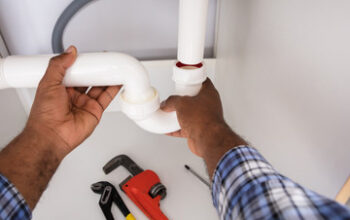Plumbing Northridge is an important profession that allows people to live comfortably. It provides clean water and a safe waste disposal system, which helps improve overall health.
Plumbing systems include piping that brings water into buildings and carries away wastewater. They also have drains that connect to sewer lines.

A plumbing system conveys water from its source to the places where it is needed. Its components include pipes, valves, tanks, and fixtures. Its purpose is to supply water for drinking, cooking, washing, and flushing sewage. It also protects against the spread of disease by collecting and transporting waste water away from human activity. The world’s plumbing systems are complex networks of pipes that carry water, sewage, and waste from our homes, workplaces, and factories. These pipes are made of various materials, including copper, PVC, PEX, galvanized steel, and more. These pipes must be durable and corrosion-resistant, whether underground or in the air.
The plumbing industry encompasses installing, maintaining, and repairing these systems. It also includes constructing water storage, treatment, and distribution infrastructure. This infrastructure consists of storage tanks, pumping stations, and transmission pipelines. It may also contain ancillary equipment such as fire hydrants and domestic fire sprinkler systems.
Depending on the need, a public or private water supply system may be surface- or groundwater-based. Typically, surface water is drawn from lakes, rivers, and streams. This water is then treated to meet the needs of residential, commercial, industrial, thermoelectric, and mining users. In addition to supplying potable water, public water suppliers often provide water for fire-fighting and street-washing purposes.
The water supply system pipes are usually installed in a gridiron pattern to allow for water circulation in interconnected loops. This allows for easy isolation of damaged sections without disrupting the entire system. Dead-end patterns are also used but can be difficult to maintain and more susceptible to corrosion and other problems.
When the water reaches your home, it passes through a meter that registers how much is used. Your home’s main shut-off valve is usually located close to the meter. This valve is important because it can stop water flow to your house in an emergency, such as a burst pipe.
A plumbing system comprises two subsystems: water supply and drainage. The water supply subsystem consists of the pipes that deliver freshwater into the home and remove wastewater. It is important to understand how the plumbing system works so that you can perform routine maintenance and spot potential problems before they become serious.
The disposal system handles sewage and other solid waste from households, businesses, and industries. It also disposes of hazardous and electronic waste. It includes the transformation operations necessary for reuse, recovery, or recycling. Reuse and other forms of waste reduction should always be pursued before a disposal process is required.
Liquid waste disposal is critical for environmental and human health protection. If liquid waste is disposed of improperly, it can contaminate groundwater and surface water sources used for drinking. This can cause illness in humans who consume the contaminated water. It can also infect the soil, killing plants and disrupting ecological systems.
For example, if the area where your business disposes of its waste contains a well water source, you must ensure the disposal site is well away from it. Otherwise, leaking waste from the disposal site can contaminate the water supply and make people ill. Inadequate liquid waste disposal can also create an offensive odor that can disturb residential neighbors. It can also harm the environment by causing a buildup of garbage that attracts rats and other pests.
Plumbing is the network of pipes and fixtures that transports water throughout a building or structure. This system includes distributing potable (drinking) water, waste disposal, and heating and cooling. Plumbing professionals install these systems, repair them when necessary, and maintain them to ensure optimal performance. Plumbers use various tools and equipment to perform their job, including pipes, valves, tubing, and fittings. Many plumbers specialize in specific types of plumbing installations or projects.
For example, a plumber may install water heaters, garbage disposals, or septic systems. Some even focus on outdoor plumbing, such as sprinkler and rainwater collection systems. Regardless of the type of plumbing project, the installation process is usually similar. The plumber will inspect the area to determine where to place the pipes and how much a system is needed. Then, they will dig trenches and install the pipes, which typically consist of copper, PVC, or PEX tubes. The plumber will connect the tubes to faucets, toilets, showers, water heaters, and other fixtures.
During installation, the plumber will also add vents to the plumbing system. These vents allow air to circulate properly and prevent sewage from building up in drainpipes, which could otherwise lead to a backup. Finally, the plumber will connect the vents to the drainage system and install any traps required by codes.
When the plumbing system is complete, it will be tested for leaks and proper operation. If any problems are detected, the plumber will correct them and try the system again. In some cases, the plumber may need to adjust the pressure in the pipes or change the direction of the water flow.
Plumbing is a trade that requires specialized training and certifications to ensure the work meets high quality, functionality, and safety standards. Many plumbers learn their trade through an apprenticeship, combining on-the-job training and classroom instruction. Others pursue post-secondary education in a technical school or community college to become certified plumbers. To become licensed, plumbers must pass a state exam and obtain a license from their local authority.

